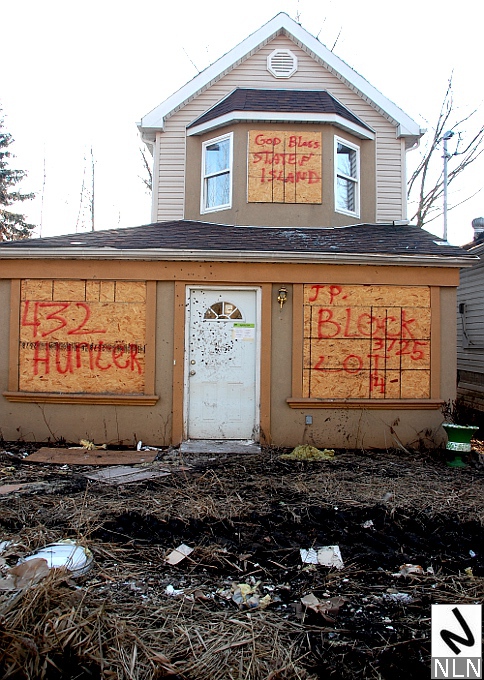
A house on Hunter Avenue, Dongan Hills, Staten Island.
(Photo: Thomas Altfather Good / NLN)
STATEN ISLAND, N.Y. — January 2, 2013. Journalists don’t often get thanked for requesting an interview — especially when they interrupt someone’s holiday — but on New Year’s Day a Sandy survivor named Elizabeth Hession said to this reporter, “Thanks for caring.”
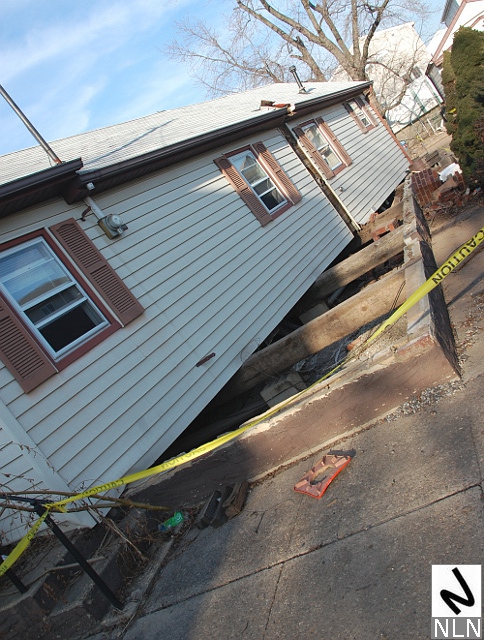
Another Hunter Avenue home, knocked off its foundation by Sandy.
(Photo: Thomas Altfather Good / NLN)
RAPID REPAIRS?
Liz Hession owns a home on Hunter Avenue in the Dongan Hills section of Staten Island. Her street was particularly hard hit by Hurricane Sandy. On the night of October 29, the 60-year-old Staten Islander stared out her window in disbelief as a wall of water roared down the avenue. She and her husband, their dog, and four birds ran for the attic. 12 hours later, they were rescued by first responders in a rowboat. The Hessions were deposited on Hylan Boulevard, in three feet of water. They were eventually located by their daughter who took them to shelter. Two of the birds died but the soaked and stunned Hessions survived Sandy. Three days after the storm, they returned home. Sandy’s flood waters had done considerable damage. Hession’s 71-year-old husband, Jim, gutted their home, cleaning the affected areas with a bleach solution, as the couple awaited the arrival of New York City’s so-called “Rapid Repairs” program. It never came.
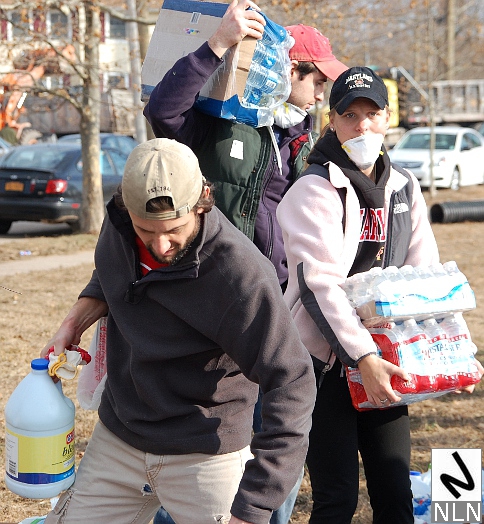
Volunteers from the University of Maryland delivering supplies in Midland Beach.
(Photo: Thomas Altfather Good / NLN)
On December 15, Liz spoke out at a forum organized by Occupy Sandy — the all-volunteer community based relief effort that maintains a “hub” in Midland Beach, not far from the Hessions. She questioned what the Red Cross was doing with all of the donations it had solicited on television and the internet.
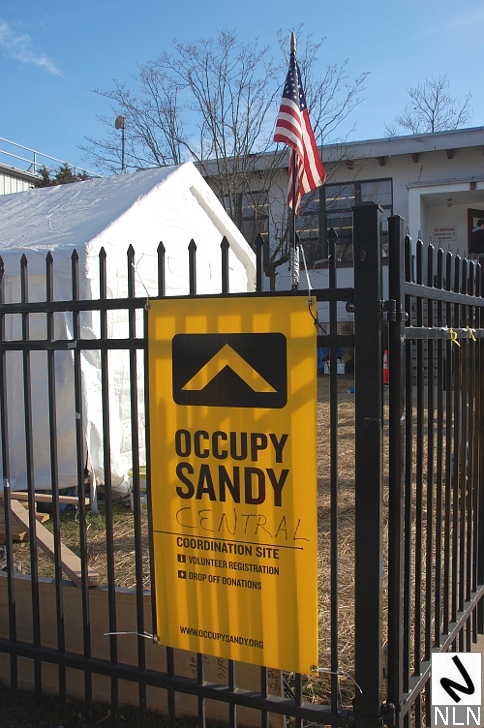
Volunteers are the backbone of the relief effort in hard hit Midland Beach.
(Photo: Thomas Altfather Good / NLN)
“I heard that people were contributing billions of dollars throughout the world, not just in the United States, not just in New York. Text something on your phone to contribute ten dollars to the Red Cross because they’re gonna be there, they’re gonna help,” she said.
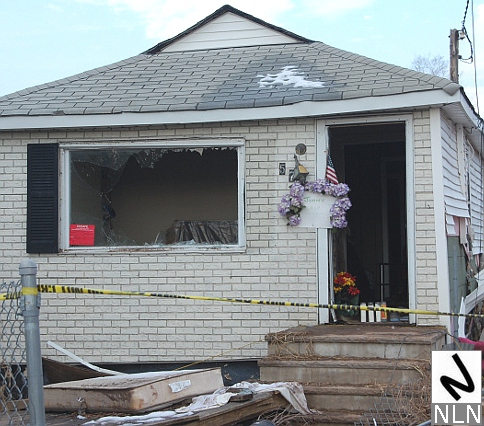
The final resting place of James Rossi, 85-years-old.
(Photo: Thomas Altfather Good / NLN)
“Where is all that money,” she asked, “I want to know where that money is right now,” she said as the audience cheered.
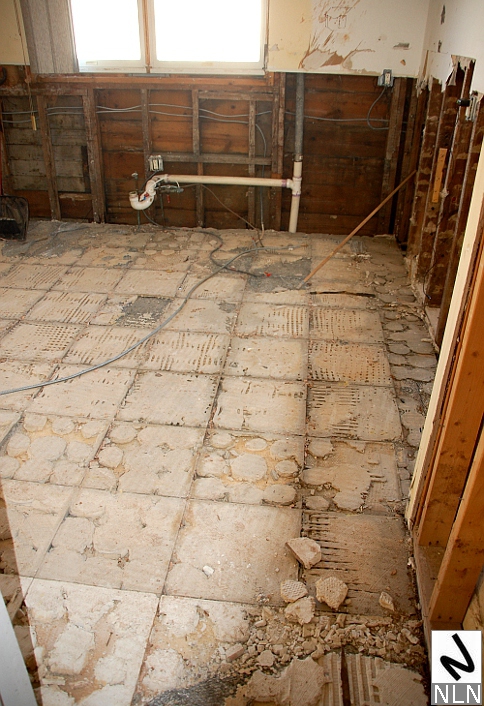
The gutted home of Slava Viner, Midland Beach
(Photo: Thomas Altfather Good / NLN)
“What I need is contractors coming in and helping us. And they’re not there. Rapid Repairs, we applied when they first came out. It’s already six weeks we’re waiting for Rapid Repairs,” she said.
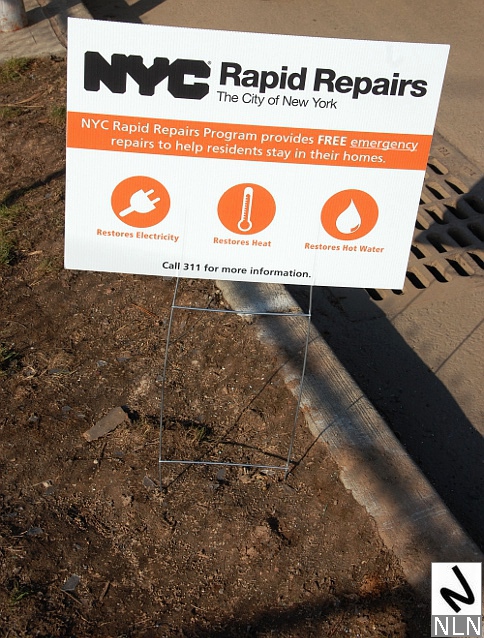
Rapid Repairs?
(Photo: Thomas Altfather Good / NLN)
Two weeks later, on New Year’s Day, Liz Hession told NLN that the only contact she had with Rapid Repairs was a phone call. A program representative had called her a few days earlier to ask if she was satisfied with the repairs effected by the City — repairs that never happened. Hession told the rep that no repairs had been done. The representative apologized and promised to get the Hessions help. Three days later another Rapid Repairs rep called, asking Jim Hession if he was satisfied. He wasn’t and he let them hear it. As of January 1, Liz Hession and her husband were still waiting for a site visit from Rapid Repairs.
“Nothing’s changed, it’s gotten worse actually, because they’re all screwed up over there,” she said.
The Hessions were “lucky” — a relative concept for Sandy survivors. They did receive $31,900 from FEMA, the maximum amount. Liz doubts that it will cover all their losses. Their home sits on a four foot concrete slab. But the house filled with seven feet of flood water — Liz said that an 11 foot storm surge hit Hunter Avenue when Sandy came ashore. The home was wet for three days and like other survivors the Hessions had a serious mold problem when the water receded. Although they used a FEMA-recommended bleach solution to kill the mold, a drenching rain in late December, and no infrastructure repair — no electricity to run a dehumidifier, could wash away their efforts at mold remediation.
“My husband did clean the mold out. But whether it’s grown back because it’s been rainy and damp and we don’t have any dry heat [ or electricity ] to run the dehumidifier or anything like that, I’m not sure. When we get back in the house, we’ll know,” Liz said.
Mold remediation is both a serious health crisis in the making and a metaphor.
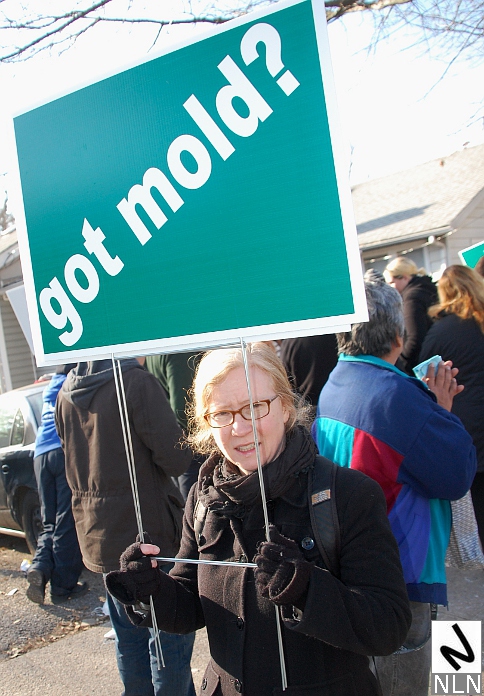
Got Mold?
(Photo: Thomas Altfather Good / NLN)
GOT MOLD?
The official relief effort has been marred by double binds and catch 22 scenarios. FEMA will not pay for mold remediation — and most reputable contractors want cash up front. Rapid Repairs provides a free boiler and restores electricity to battered homes but their workers will not enter a dwelling if they find that mold is present.
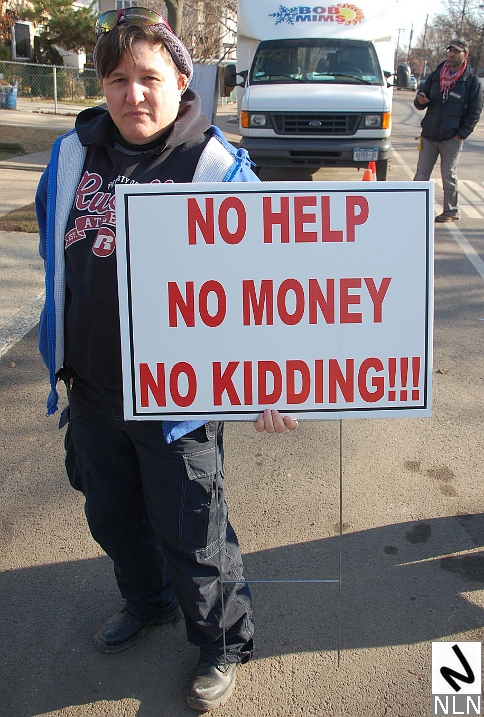
Health care worker — and Midland Beach resident — Lyn Governale.
(Photo: Thomas Altfather Good / NLN)
Addressing participants at the December 15th Occupy Sandy community speakout, Midland Beach resident Lyn Governale described the problem.
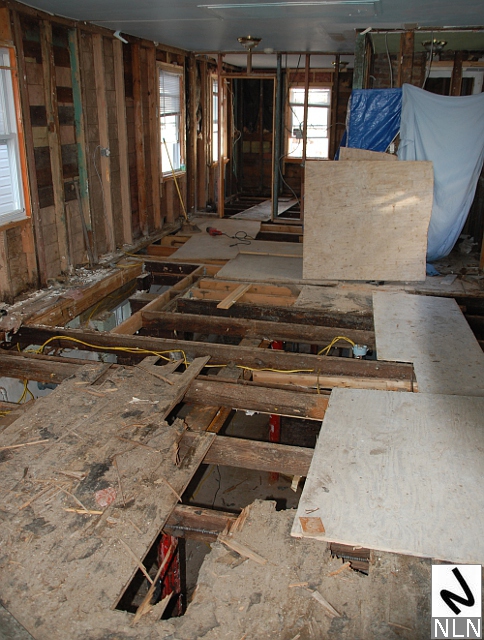
The interior of Governale’s home.
(Photo: Thomas Altfather Good / NLN)
“My neighbors lived in their house for 30 years — they can’t come back. Just so many people feel like they don’t know where to turn, they don’t know who to turn to. Insurance companies aren’t coming through for us. FEMA has been minimally helpful. I see my neighbor rebuilding her house — with mold in it. And she just thinks she has to just keep going,” an emotional Governale said.
“We need help out here,” she added.
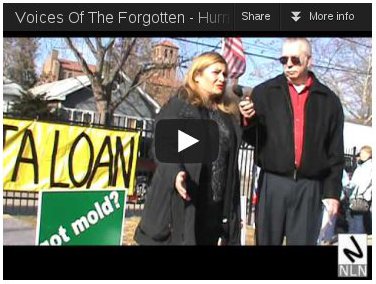
Click to hear Sandy survivors speak out. (Video)
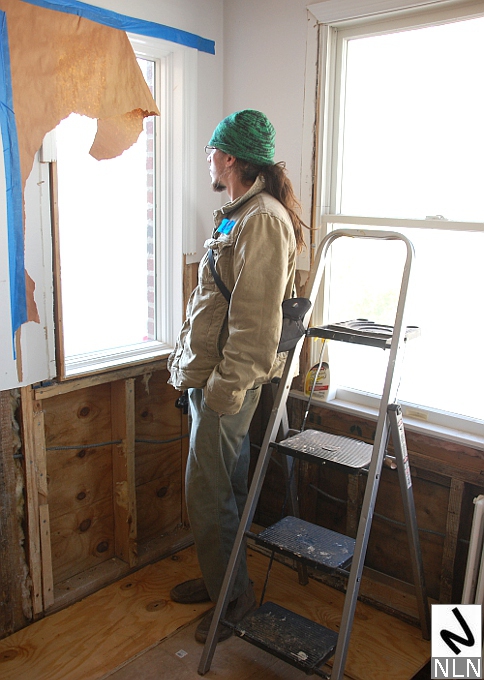
Waiting for the insurance company…
(Photo: Thomas Altfather Good / NLN)
IN GOOD HANDS?
Angela DeSanno wasn’t at home when Sandy came calling. The social worker was on vacation — stuck on a cruise ship with no way to get home.
“I was on the phone with my family — my son, daughter and mother — through the storm until the phones went dead,” DeSanno told NLN.
DeSanno’s mother, who lived in the lower level of the Mother-Daughter house, knew that the family home was in Zone B and therefore, according to the Mayor’s office, they didn’t need to evacuate.
DeSanno’s son Anthony had bought all the recommended items — water, batteries, tape for the windows — and reassured his mother that everything would be fine.
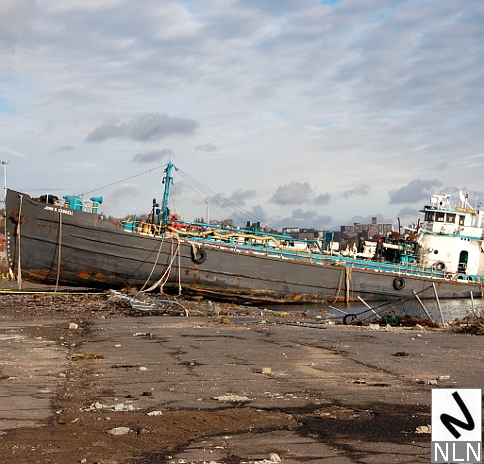
A 185′ water tanker parked on Front Street in Clifton, Staten Island.
(Photo: Thomas Altfather Good / NLN)
“The night of the hurricane was kind of weird. We were all on the phone and my mother kept saying that it was barely raining. She said that she thought the weather reporters got it wrong again! She kept saying that she was going downstairs to go to bed,” DeSanno said.
“When I moved to Staten Island from Brooklyn 25 years ago, the realtor told us the house was considered a Mother-Daughter. She said that our home was a little more expensive than others that were similar because we were ‘above the Boulevard.’ Coming from Brooklyn, I had no clue what that meant. Apparently, you don’t have to worry about flooding or water in your apartment when you live above the Boulevard. Through all the years that we have lived here, we never had an issue. My mom’s apartment never got any water during storms,” she said.

A storm-damaged car: water inside, seaweed in the grille.
(Photo: Thomas Altfather Good / NLN)
This changed on the night of October 29. Brittany, Angela’s daughter, looked out the window of the second level, concerned about wind damage. She saw cars going down the block at high speeds — in reverse. DeSanno’s kids woke their grandmother and brought her upstairs. Within minutes the back doors of the house were blown out by a massive surge of water. The grandmother’s apartment filled with flood water and the second floor apartment also took in water.
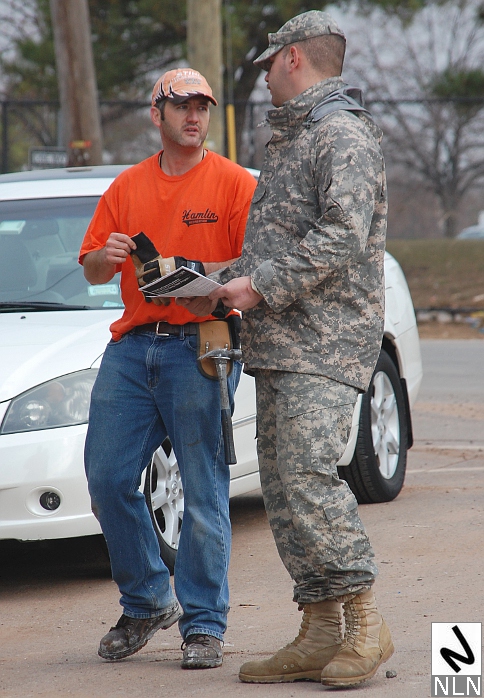
A grunt hands a nyc.gov flier to a homeowner in Midland Beach.
(Photo: Thomas Altfather Good / NLN)
“My family was trying to call 911 but was unable to get through. At that point, my contact with them ended as the phones went dead. My family was rescued that night by the Coast Guard — with boats! My mother was taken to Staten Island University Hospital with chest pain and my kids slept on the floor of the hospital with wet clothes. The hospital was having problems of their own,” DeSanno said.
DeSanno lost the use of her mother’s badly damaged apartment and all of its contents. The family lost their cars, furnace, hot water heater, and electrical panel. The second floor apartment was damaged but the family remained there, without heat, electricity or hot water — having no where else to go. An insurance adjuster was able to get them a $3,000 advance from their insurance company. He told the family that they had several thousand dollars in damage.
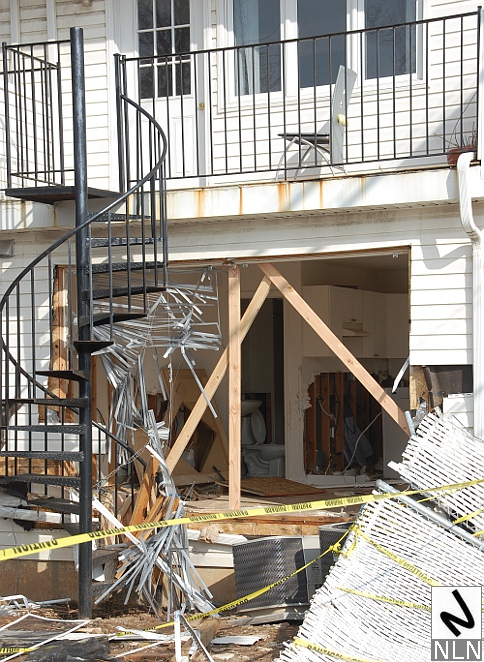
In South Beach: a home missing an exterior wall.
(Photo: Thomas Altfather Good / NLN)
“My son and daughter contacted FEMA, and my flood insurance and home owners’ insurance company, State Farm, two days after the storm. All paperwork was filled out and completed by day four. It is now January 2 and we still have not heard a word from anyone,” DeSanno told NLN.
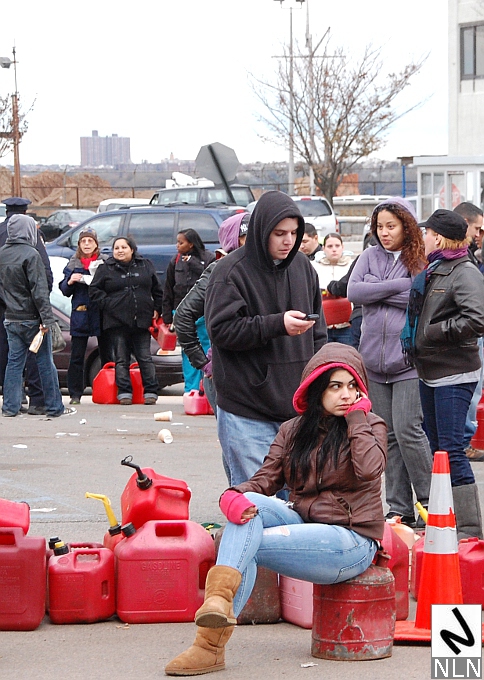
Staten Islanders on line to get gas for their generators.
(Photo: Thomas Altfather Good / NLN)
“My son Anthony suffered second and third degree burns on both arms the week after the storm — bringing a pot of boiling water to the upstairs bathroom so I could take a hot bath. He fell with the pot. He lost his job and did not have any medical coverage. One of the nurses told us that FEMA should be able to help with the medical bills as his injury was related to the storm. No word from FEMA on that issue either,” DeSanno said.
Adding to the misery was the threat of looters.
“There was looting in the first week or so. My daughter was followed into the back yard by a man who looked like he was a drug addict. It was around 5:00 pm, just getting dark and she was coming home from work. My son saw her and came out of the house and questioned the man. He made up a story and left the property. I’m not sure about my neighbors [experiences]. Many of them have not come back to the block yet.
DeSanno’s insurance company has indicated they will not cover any possessions that were destroyed when the first floor flooded — because the apartment was in a “basement” area. This issue was never raised during the years the company collected premiums.
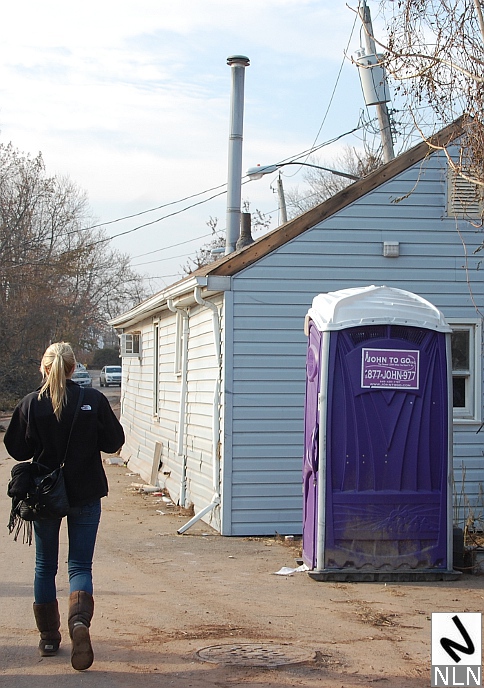
A house on Quincy Avenue — its foundation is on the other side of the street.
(Photo: Thomas Altfather Good / NLN)
The DeSanno’s are not alone. Many Islanders have had insurance claims denied primarily because most hurricane insurance only covers wind damage, not storm surge. In addition insurance companies have argued that if a policy lists any “excluded peril” and the damage suffered is a mix that includes any such exclusion (“multiple causation”) then the claim can legally be denied. Once a victim is denied by their insurance company they may be eligible for a lower interest FEMA loan, usually 1.688 percent to 4.0 percent. But only after they are denied a bank loan — whose interest rates range from 3.375 to 6 percent.
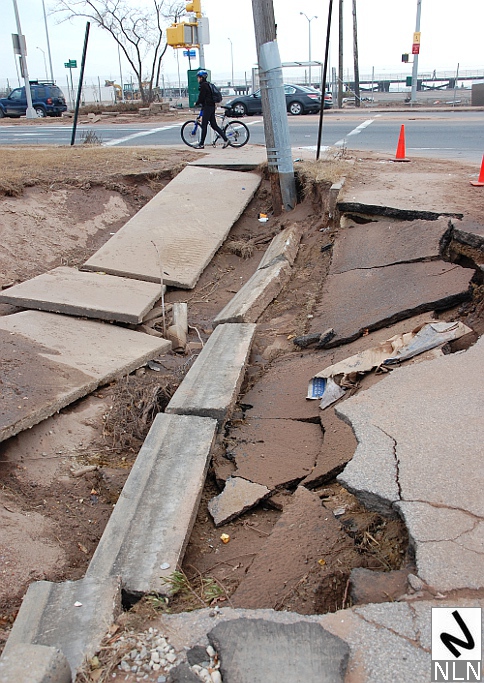
A large sinkhole outside South Beach Psychiatric Center.
(Photo: Thomas Altfather Good / NLN)
Many homeowners who have been denied by their insurance carriers are faced with a choice: foreclosure or taking on more debt. A high interest loan and a mortgage on a home that has lost most of its value is a distressing prospect. In addition, FEMA home loans are capped at $200,000 and the agency requires collateral.
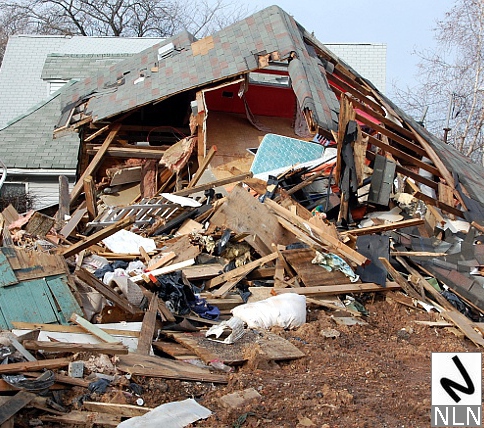
A pile of shingles on Cedar Grove Avenue in New Dorp Beach.
(Photo: Thomas Altfather Good / NLN)
As a result of community members not being able to get viable assistance, some neighborhoods resemble ghost towns. Some homeowners have simply walked away from their shattered homes, being unable or unwilling to take on crippling debt. Those who do return have no way of knowing if the house next door will ever be reoccupied. The official death count on Staten Island, with Midland Beach being hit the hardest, is 23. But many more people are simply not accounted for — their whereabouts are unknown. High interest loans, devalued properties, and missing neighbors weigh heavily on the minds of those who choose to rebuild.
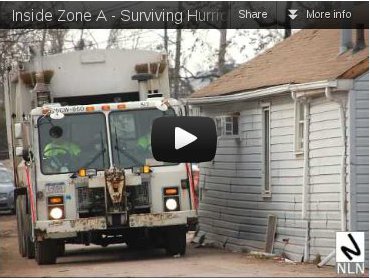
Click HERE to see “Inside Zone A” (Video)
Addressing her fellow survivors at the December 15 speakout, Midland Beach resident Simona Safari was visibly upset. Speaking about the issue of having to pay interest on FEMA loans she asked, “Why [do] the state and government have to make money on us?”
Adding to the cost of rebuilding, Safari said that the City will not re-evaluate property values before calculating next year’s property taxes, despite the fact that many homes are now worth a fraction of their pre-disaster value and the homeowners are being forced to take on additional debt. Safari blasted the Mayor who has been silent on this and other issues.
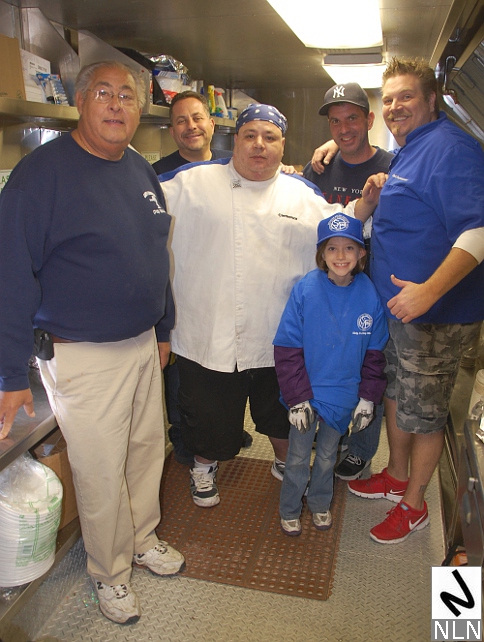
Celebrity chefs Clemenza (center) and Burmeister (right) serving free food in Midland Beach.
(Photo: Thomas Altfather Good / NLN)
“Our mayor is again preoccupied with the issue of sodium intake. And how much soda we drink. Where is he?” she asked.
In a report entitled “Shouldering the Debt,” an Occupy Wall Street “offshoot” called Strike Debt pointed out that, “The focus on lending moves money from the victims of disaster into the hands of loan servicers who make $1 billion in profit annually off of these loans,”
Things aren’t much better for small business owners. Small Business Administration loan applications are 30 pages long — and many Sandy victims report that their personal papers, including documentation required by the SBA, were destroyed by flood waters.
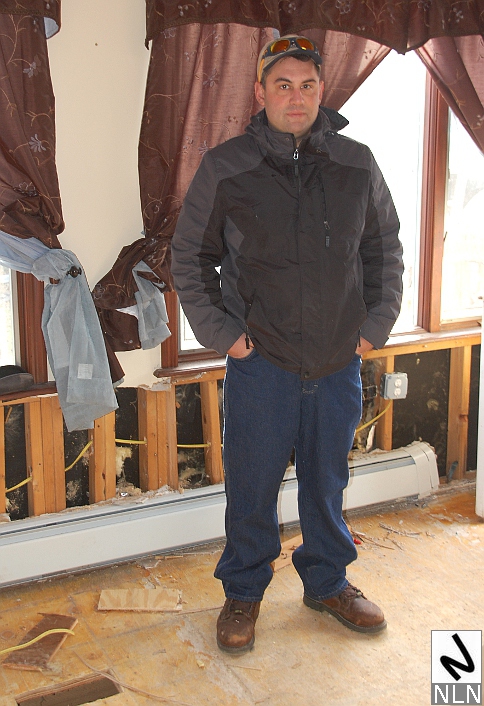
Sam Cocozza in his New Dorp Beach home.
(Photo: Thomas Altfather Good / NLN)
RETURN TO NORMAL?
Sam Cocozza lives in New Dorp Beach. During the storm his basement filled with water and the tidal surge left a foot of water in his family’s living space.
Cocozza’s in-laws lived a few streets closer to the water and their home also flooded. Like many families in the area, they had wanted to ride the storm out in order to protect their property but the tidal surge washed away those hopes. Many of the residents of New Dorp Beach, including Sam and his extended family, ran — or swam — for their lives as the surge pushed a wall of water into their community, filling the streets and their homes in a matter of minutes. Wanting to escape together, Sam tried to get to his inlaws’ house to pick them up — but the water was moving too fast. He found them later, safe but soaked and shivering. They were shaken but they had survived.
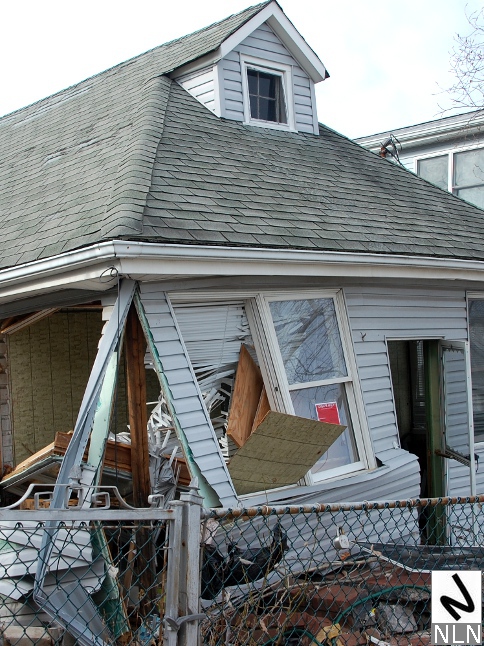
Cedar Grove Avenue — a few blocks away from Cocozza’s home.
(Photo: Thomas Altfather Good / NLN)
Around midnight the tide receded somewhat and rescues began — many residents of New Dorp Beach were trapped in their attics or on rooftops. The survivors found themselves wet, weary, and homeless. After basic survival needs were addressed thoughts of rebuilding began to emerge. But recovery would be a very long process.
As a Verizon employee, Cocozza worked long shifts restoring communications for storm victims, even though his own home was flooded.
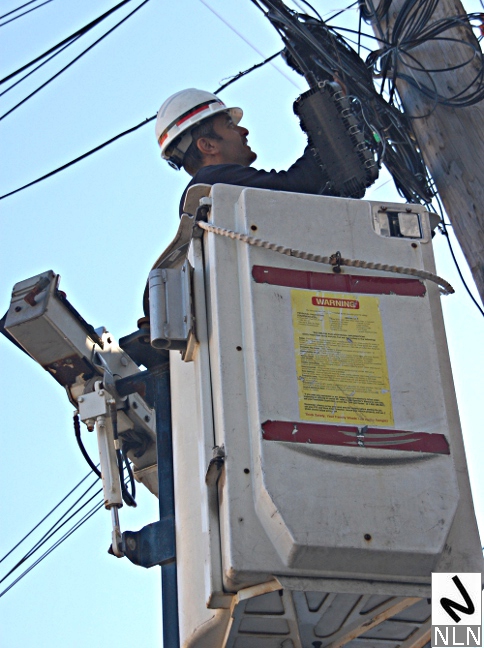
A Verizon worker on the job in Stapleton.
(Photo: Thomas Altfather Good / NLN)
“We were forced [ to work ] twelve hour days, to restore other peoples’ service. Telephone poles were down so peoples’ tv and internet services were out, telephone lines were down, so yeah we were forced to work 12 hours days. At least for the first four or five weeks after the storm hit.
In the affected areas you had a lot of people that were still living there and they wanted their tv and internet back, it was important to them. But I had a feeling that almost all of the fixes were temporary. We’re obviously going to be back there once their construction is done. It was more, seemed to be like, making people feel better — more than an actual fix.
We had worked on one block where the gentleman was almost shell shocked. He was glad to see us repair his services but he mentioned that there was four dead people on the block. In general there were some shell shocked people. It was tough. It was tough seeing devastation after devastation. And there were different degrees of devastation. By me in New Dorp Beach, we thought it was pretty wrecked but then as you go down to areas closer to the water, you see — it gets worse. There are different levels of devastation, I would say, from bad to worse. There were several blocks, I worked in Oakwood Beach and Midland Beach, and two times people told me that there were two or three people dead on the block.”
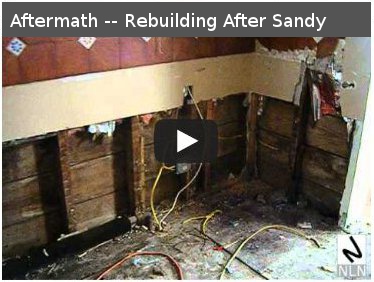
Click HERE to see Sam’s home (Video)
Cocozza applied for New York City’s “Rapid Repairs” program.
“The Rapid Repairs I’m going through now, and it is slow. The time between the electrician comes and the boiler guy comes, it’s slow but all things considered…” he said.
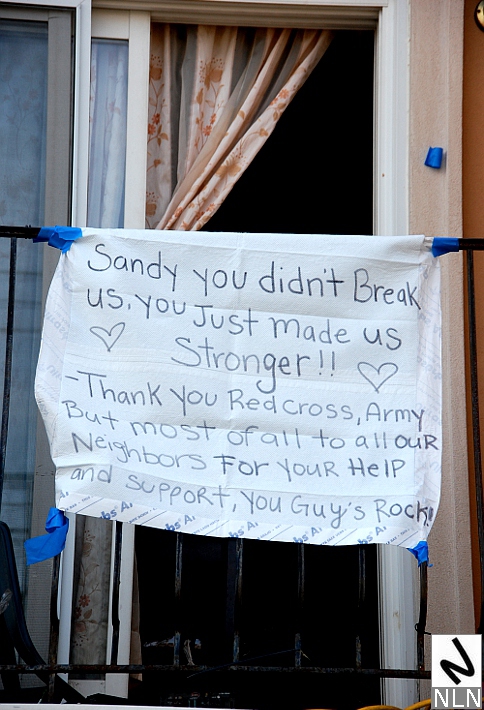
Survivors on Sand Lane (South Beach) express their gratitude to all who helped.
(Photo: Thomas Altfather Good / NLN)
Cocozza said that the Red Cross was on the disaster scene relatively quickly but their activities were limited to distributing food, and the food didn’t compare to what local businesses were offering. Local pizzerias stepped up, in true New York fashion, delivering pizza to people who were sticking it out in their homes.
“It was almost like, ‘no thanks Red Cross, there’s pizza behind you.’ Or a college kid walking along with a shopping cart full of Subway sandwiches,” Cocozza said.
Sam doesn’t expect a quick fix, even with “Rapid Repairs.”
“There’s a long way to go. About 50 percent of the people have moved back in. While the lower floors are being repaired they’re living on the upper floors,” Cocozza said.
As with Hession and Governale, mold remediation is a big concern for Cocozza who not only worries for his neighbors’ well being but also has to work in their homes, homes that could be filled with black mold.
“People are putting sheetrock back up without doing any of that [ remediation ],” he said. Cocozza paid a service to dehumidify his home and to use anti-microbial spray to kill the mold – trying to do remediation the right way – but not everyone has the resources to pay for remediation. The net result is that people are using bleach, vinegar and even anti-freeze to try to kill the mold. Cocozza points out that the FEMA website states clearly that bleach WILL kill the mold on smooth surfaces. But wooden beams are not smooth. And so the mold may return.
While his home is drying out and being slowly brought back online Cocozza continues to work in the field, encountering other hazards. Although it took a little prodding, Verizon management did eventually provide masks and rubber gloves. Then Cocozza, a CWA steward, had to educate his coworkers that they needed to be safe.
Sheetrock dust, asbestos, mold and other airborne toxins make masks essential. And gloves protect workers from all that the storm waters carried into the victims’ homes.
“There’s sewage all over all the equipment we’re touching,” Cocozza said.
For Sam, his coworkers, and his fellow Staten Islanders, it will be a very long time before anything resembling normalcy returns to their lives.
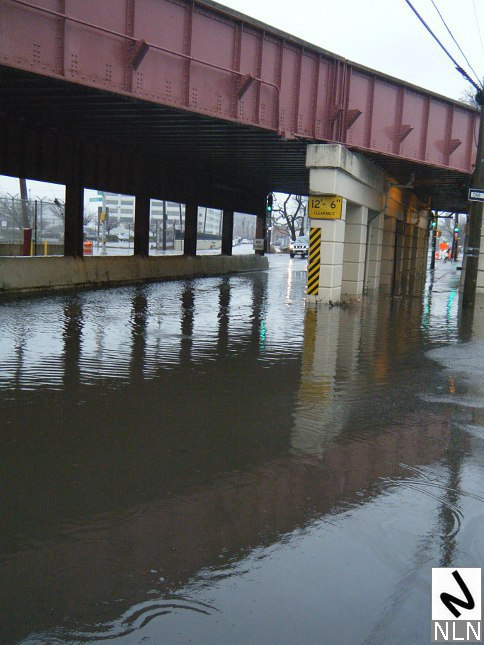
Clifton, Staten Island.
(Photo: Thomas Altfather Good / NLN)
EPILOG
Although it is something of a cliche to refer to Staten Island as “The Forgotten Borough,” it remains by and large an accurate description — at least in the minds of its residents. FEMA took over five days to arrive on Staten Island; the Red Cross was late getting to Midland Beach — and when they arrived all they had to offer was poor quality food; and Rapid Repairs is, by most accounts, anything but. The Mayor’s response has been criticized by survivors, the Congress has been brutally slow in providing aid, and the only politician to take action on the mold crisis is Public Advocate Bill de Blasio. The voices of the forgotten borough are crying out for help as they struggle to rebuild. Is anyone listening?
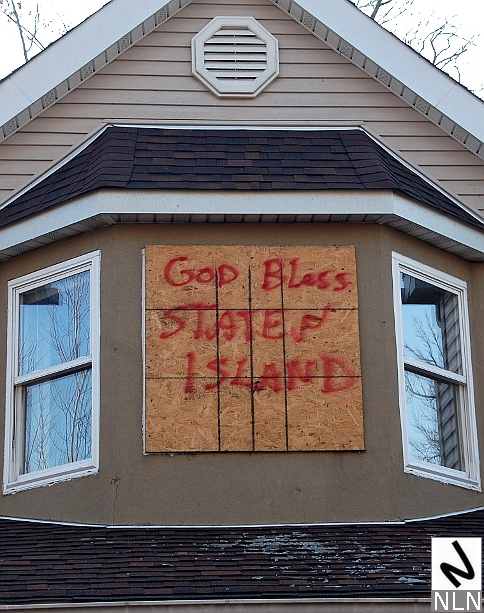
“God Bless Staten Island…”
(Photo: Thomas Altfather Good / NLN)
Thank you to Angela DeSanno, Mike Dimino, Sam Cocozza and all of the First (and Second) Responders who are helping others while rebuilding their own lives. — Thomas Altfather Good, West Brighton, Staten Island.
Click To View Photos and Videos…